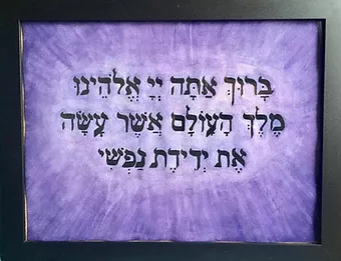Calling non-binary people to Torah
"How should we honor non-binary individuals called to the Torah?"
This source is a Responsa, שאלות ותשובות, to the above question and provides in depth explanation for their practical uses and their biblical justification. Traditionally, when someone is called to the Torah, the gender of the person would determine what language is used to call this individual up. This Responsa from the Conservative movement’s halakhic decision-making team provides structured language that honors non-binary individuals, maintains the traditional textual allusion of being commanded to "come up," and the Minhag, מנהג.
Read the Responsa here from the Committee on Jewish Laws and Standards (CJLS)

Prayer but Gay
The Modeh/ah/et Ani is one of the morning prayers recited upon waking up that thanks G-d for waking us up and returning our soul to our body. The Non-binary Hebrew Project crafted a source for applied uses, including this suggestion below for Morning prayer, Shabbat Prayers that expand on the Divine, prayer thanking G-d for our soulmates, and much more.

Queering Life Cycles: Brit Milah & Baby Naming
This non-binary guide to both a brit milah and baby naming ceremony was created by a former rabbinical student and current rabbi Noam Lerman. It is subtitled "Brit Ceremony to Affirm the Little One’s Identity as Being Part of the Jewish People" and includes options with and without circumcision along with non-gendered prayers.
Queering Life Cycles: B'nei Mitzvahs
This guide provides suggestions and current best practices for gender-neutral or gender-inclusive b'nei mitzvah ceremonies. It includes adaptations to traditional rituals as well as considerations for event space, written materials, and additional ritual components. Keshet is a great organization for LGBTQ Jewish resources.
Queering Life Cycles: Weddings
This source is a ritual template written by Rabbi Elliot Kukla, a queer nonbinary rabbi, for creating a Jewish wedding service that celebrates gender and sexual diversity. This ritual template is very similar to a traditional Jewish wedding. There are some linguistic changes in the service to more honestly speak to a variety of different identities, but the flow of the ritual follows the classical pattern. Ritualwell is an online resource for Jewish rituals that are LGBTQ inclusive and feminist.

Queering Life Cycles: Death
After a Jew dies, a burial society, known as chevra kadisha (literally, “holy society”) prepares the body for interment. This process, called tahara (purification), involves the ritual cleaning of the corpse and is traditionally highly gendered and segregated.
The Gender Task Force of the Community Hevra Kadisha of Greater Boston created this resource to provide a framework for inclusion of transgender and gender non-conforming Jews in traditional Jewish death and burial practices. It includes new liturgy, suggestions for trainings, the results of a survey of TGNC Jews, a discussion of the relevant halacha, and other concrete suggestions for the inclusion of folks of all genders in tahara. As this resource states, "our goal is to improve our own hevra’s ability to include trans and gender non-conforming people appropriately in our hevra and to serve them in death."
Toward a Gender-Inclusive Hevra Kadisha
Wearing Kippot: Becoming a Good Boy
Max K. Strassfeld writes about their experience with being a transmasculine individual and how embracing wearing Kippot helped to challenge gendered narratives tied to the mitzvah but also empowered them individually. Strassfeld writes of how they come across a kippah in a Judaica store that is inscribed with "Yeled Tov" meaning Good boy and how it evokes great emotion in them. The commandment to wear a head covering, traditionally for men, comes from the Talmud (Shabbat 156b) which tells us that the Kippah is a physical reminder of G-d always being with us and reminding us to do good. Being a good boy is given new meaning by Strassfeld who says, "Purchasing my kippah would have felt less loaded with symbolism if I had worn a kippah regularly when I (tentatively) identified as a woman. I wear it now because I relate to the object differently now. Like all good rituals and ritual objects, this kippah has meaning for me; it calls to me as a way to declare my genderqueerness. In effect, yeled tov is the reason that I fulfill this particular mitzvah (commandment)."




